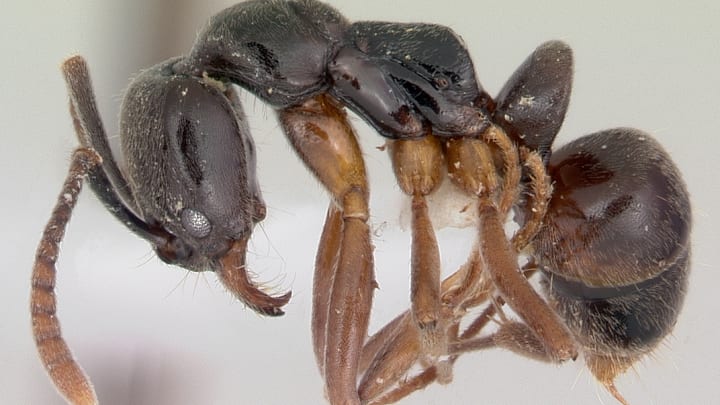Scientists estimate there are around 20 quadrillion ants on Earth, most of which are harmless to humans. But experts are concerned about one non-native species gaining ground in the U.S. The insects are called Asian needle ants (Brachyponera chinensis), and one sting can send sensitive individuals into anaphylactic shock. Here’s everything you need to know about the invasive insects.
- Where Do Asian Needle Ants Live?
- Why Are Asian Needle Ants Dangerous?
- How to Identify Asian Needle Ants
Where Do Asian Needle Ants Live?
As the name suggests, Asian needle ants originated in Asia, specifically China, Japan, and Korea. They were discovered in the United States in the 1930s and labeled pests in 2006. Their numbers have continued to grow. Though they’re concentrated in the South, Live Science reports that entomologists documented the species in various Midwest and New England states in recent years.
Why Are Asian Needle Ants Dangerous?
The surge in Asian needle ant populations is concerning because their stings can trigger a potentially life-threatening allergic reaction called anaphylaxis. The condition is characterized by intense, fast-acting symptoms, like swelling, wheezing, rashes, and dizziness, depending on its severity. At its worst, anaphylaxis can cause death, as a person could lose the ability to breathe and their blood pressure could plummet. Food allergies are the most common cause of the reaction, but insect stings, medication, and latex can also trigger it. Officials currently don’t know how many people have died from anaphylaxis caused by Asian needle ant stings worldwide or in the U.S.
Unfortunately, scientists can’t say which people are most likely to have adverse reactions to the insect’s sting. Dan Suiter, a professor of urban entomology at the University of Georgia, tells Fox Weather that people who’ve experienced dangerous reactions to other insect stings should be especially careful and carry EpiPens. However, it may be possible to be allergic to the ants even if other insects don’t bother you. Everyone should be on the lookout for Asian needle ants, regardless; potentially life-threatening symptoms aside, their stings are pretty painful.
How to Identify Asian Needle Ants
These tiny critters are about three-sixteenths of an inch long, with dark exoskeletons and orange tips on their legs and antennae. Asian needle ants typically live in logs or firewood, but people have also spotted them under stones and in piles of leaves. The insects can be challenging to identify, but they aren’t aggressive or territorial, and are often found wandering alone.
Read More About Insects:
